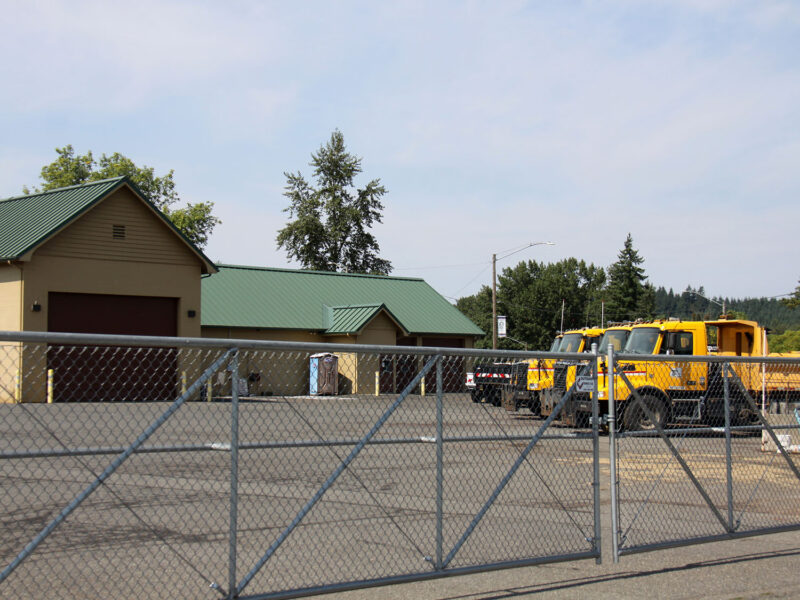By Satina Tolman
For The New Era
Sweet Home’s Oregon Department of Transportation facility, along with others around the state, will likely be closed even if ODOT gets a cash infusion from the Legislature this week, according to an agency spokeswoman.
“The Sweet Home maintenance facility has not yet closed. Closures will begin in phases over the coming months,” said Mindy McCartt, ODOT public information officer for Linn, Lincoln, Benton, and Lane counties, before the Legislature’s short session began Friday, Aug. 29. “The exact timing depends on the outcome of the special session and the layoff and bumping process, which can take months to finalize.”
ODOT has said it will need to lay off 483 employees and eliminate another 449 vacant positions, citing flattening gas tax revenues, inflation, and legal restrictions on how funding can be spent. Although ODOT says it has cut nearly $300 million over the past five years through efficiency measures, the agency says the shortfall is now unavoidable.
“Cutting maintenance work will likely cost more in the long run,” ODOT warned in mid-August. “Routine work like repairing pavement, clearing drains, and plowing snow prevents small issues from becoming major ones. Without it, Oregon’s transportation system will become less safe and less reliable.”
Sweet Home ODOT Impact
After failing to pass a scaled-back transportation $5.8 billion funding bill (House Bill 3991) in June, which was reduced from an initial $11.7 billion proposal, Gov. Tina Kotek called the legislature back into session Friday to consider a proposed funding package that would raise $620 million through increases to registration and gas taxes. That, state officials say, would cost the average driver about $5.50 per month. ODOT’s share — just over $300 million — would be enough to stop layoffs and restore services.
 However, according to McCartt, even if the special session passes the funding package, the Sweet Home Maintenance Station is expected to be closed.
However, according to McCartt, even if the special session passes the funding package, the Sweet Home Maintenance Station is expected to be closed.
“The Albany and Santiam Junction crews are the closest facilities that will cover the area,” she said. “These crews will take on additional miles, which will reduce service levels compared to what Sweet Home has historically received.”
Residents will need to prepare for slower and less frequent snow and ice removal, particularly on rural and mountainous routes, she said.
“Communities can prepare early for winter travel by carrying chains, monitoring TripCheck.com before heading out, and adjusting travel plans during storms,” McCartt said.
Public updates will continue through TripCheck, social media, and news releases. McCartt concluded, “We remain committed to keeping highways as safe and passable as possible with the resources available. We are also hopeful that the current legislative concept will be passed during the special session, which would prevent the need for closures like Sweet Home and help us maintain stronger service levels statewide.”
Emergency Response Risks
Sweet Home Fire District Chief Nick Tyler described ODOT as a critical partner in keeping both emergency responders and the public safe.
“We work with them fairly closely; they are a good partner of ours,” Tyler said. “Anytime we are operating in the roadways, ODOT is very helpful in maintaining those scenes and getting roads open for us.”
During wildfires and traffic accidents, ODOT crews often help close roadways, put up signs, and maintain perimeters to prevent unauthorized traffic from creating hazards. Throughout the year, the department assists at car accidents, providing traffic control so firefighters and paramedics can safely care for victims.
“The impact of not having those resources close to us could mean that we are on scene for a lot longer, reducing our ability to respond to the next call,” Tyler warned. “We will have reduced numbers actually physically dealing with the patients because we’ll have to have dedicated people to control the traffic. Anytime we are working on a roadway, it is unsafe. To be able to control that either with firetrucks and firefighters or ODOT and their equipment is a huge priority for us.”
He noted the geographic scope of the district, which extends to Clearlake Junction, some of Highway 126 on the west side, and parts of Highway 22, meaning delays on any route could affect a broad area. “Without ODOT nearby, the time to respond to accidents, fires, or other emergencies could increase dramatically, putting both responders and the public at risk.”
Tyler said winter poses a particularly serious risk. “If Highway 20 is not being fully maintained and graded, or plowed, and keeping that roadway open, it could be a potential issue, especially in the far east of our district, where snow can reach seven inches to a foot. ODOT has done a good job in the past of keeping that open for us and allowing us to respond.”
McCartt added context for residents: “With fewer crews, residents may see more frequent delays and longer-lasting closures during severe weather events, particularly on Highway 20 over the pass. State highways are prioritized for plowing and sanding based on safety, traffic volume, and impact to commerce. Highways 20, 228, and 22 are all important routes in Linn County and will remain part of our winter operations plan, but drivers should be prepared for longer response times and the possibility of more closures.”
Schools Face Disruptions
SHSD Superintendent Terry Martin warned that school closures could become more frequent without local ODOT support.
“We’ve been able to keep weather-related closures to a minimum, but that’s only with ODOT’s support. Without them, our ability to safely transport students is really jeopardized,” Martin said.
School Transportation Director Daryl Bidwell described the reliance on ODOT crews for winter sports and curriculum trips:
“If a bus is going over the pass to Sisters, for example, for a winter sporting event, I would call my contact at ODOT and let them know a bus was traveling over. They (ODOT drivers and trucks) would be really kind and be there waiting or just ahead of us, already plowing and sanding the road. By the sounds of it, if they are closing our facility, we won’t be getting that service.”
That loss could affect ski and ride club trips to Hoodoo, curriculum trips, and even bus travel on Highway 228 out to I-5. “Last year was just phenomenal on the road care that they did. It was really good, and we could always count on our roads to be cleared. This year, if they are not going to be there, I don’t see that 20 or 228 will have the care or safety concern that they had supplied last year,” Bidwell said.
McCartt confirmed ODOT’s continued efforts: “We recognize the concerns raised by local fire, police, and school officials. Our crews will continue to respond to emergencies and weather events, but response times will be slower due to the broader coverage areas. We will continue working closely with local partners – including emergency responders, schools, and city and county officials – to coordinate responses and share updates as conditions change.”
Public Safety Impacts
Sweet Home Police Chief and City Manager Jason Ogden emphasized ODOT’s role in keeping roads safe.
 “ODOT keeps our roads plowed and safe. They treat for ice and set up digital signs when there’s a crash. If we lose that local support, we’ll see more risks and more crashes,” Ogden said.
“ODOT keeps our roads plowed and safe. They treat for ice and set up digital signs when there’s a crash. If we lose that local support, we’ll see more risks and more crashes,” Ogden said.
He also discussed ongoing infrastructure concerns: “For example, now that the City’s transportation plan is complete, I met with them recently about the intersection of Highway 20 and Pleasant Valley Road. There’s ongoing communication about what that will look like, but with the budget cuts, improvements like this, along with regular road maintenance, will likely take longer to happen.”
Ogden encouraged residents to act: “The most powerful thing we all have as a community is our voice. Contact your state representatives and explain how these decisions will impact Sweet Home.”
City Leadership Responds
Mayor Susan Coleman stressed both concern and determination.
“The closure of the Sweet Home facility definitely poses a threat to public safety and to economic development,” Coleman said. “If fewer travelers can safely get to the mountains, fewer will stop and spend money in our town.”
Coleman added, “It’s a wait-and-see kind of game, but I am not waiting. I am gathering information from as many individuals as I can and trying to come up with a backup plan if things do not get worked out at the state level. We will be exploring what the city can do and prepare for potential problems. Sweet Home is one of the strongest communities I have ever seen, and when it comes to difficulties, Sweet Home rallies together and helps each other out. We get together and make things happen. What I’d like to harness is that creative genius that lives in Sweet Home to problem solve.”
She encouraged residents to share their ideas: “Even if one idea is not feasible, it can spark additional solutions that work. Email me anytime.” [email protected].





